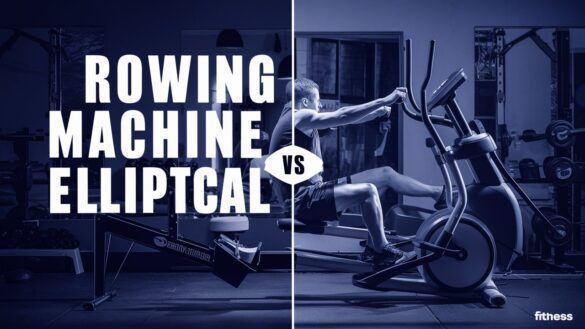Read Quick Answer
Rowing machines and ellipticals give fabulous low-impact cardio exercises. When the rowing machine tugs on more muscles and so gives a whole body workout, the elliptical treats joints more gently and provides weight-bearing exercise to enhance cardiovascular health.
Introduction
Choosing the right cardio machine to buy for working out from home can prove to be very challenging. In the many viable options available, you have a rowing machine and an elliptical trainer at the top of your list.
Both machines own varieties of features and benefits targeting different kinds of fitness goals. Therefore, this blog will give a detailed comparison of both machines so as to enable you to choose the best one for your needs.
Basics about These Machines
What is a Rowing Machine?
The rowing machine is self-explanatory a device that simulates the action of rowing a boat. It also bears the motion of contractions for the muscles of both upper and lower body parts, hence training the entire body.
This same machine is pretty famous due to having an excellent cardio, great muscle potential at the same time burning out a lot of calories.
Define Elliptical?
An elliptical machine replicates walking, running, and climbing the stairs; it simulates non-weight-bearing aerobic exercise. It is low-impact to isolate a cardiovascular workout and is easier on joints compared with running on concrete or other hard surfaces.
This leads to better cardiovascular health and raises the bar on endurance.
Rowing Machine Compared to an Elliptical
Variation of Exercises
Rowing Machine
- It provides a full-body workout whereby you exercise the back, shoulder, arms, core and the legs.
- It comes in handy during HIIT and state cardio.
- Useful for developing both strength and endurance.
Elliptical
- Low-impact, non-jarring cardio exercise—easy on joints
- Most include upper body engagement through the handlebars
- Adjustable resistance and incline provide versatility in workouts
Convenience and Accessibility
Space
- Rowing machines fold up to be stored away, making them quite effectively usable in smaller spaces.
- ellipticals consume more floor space and vertical space.
Ease of Use
- Both machines are fairly easy to use with little, if any, learning curve.
- While ellipticals are way easier to use thus suited for all fitness levels.
Safety and User-Friendliness
Rowing Machine
- Requires proper form and technique to avoid injury in the lower back.
- Good for people who have any joint problems because it doesn’t have that much impact.
Elliptical
- Has a very smooth movement that places minimal impact on the knees and hips.
- Produces a smooth movement and is ideal for older users and those returning from injuries of any kind.
Advanced/plain Training Techniques
Rowing Machine
Great for intense workouts and muscle endurance. It engages multiple rowing techniques to hit different muscular groups, particularly large muscle groups.
Elliptical
It has high-intensity interval training and a steady-state cardio facility. Replenishment and angle can adjust settings that increase workout intensity.
Effectiveness in Building Strength and Endurance
Rowing Machine
There is an engagement of multiple muscle groups that promotes overall strength development. This machine works efficiently on both upper and lower body strengthening.
Elliptical
The machine works on major cardiovascular endurance but provides only moderate strength benefits, mostly to the lower body.
Cardiovascular and Functional Training
Cardiovascular Benefits
Both machines improve heart health and cardiovascular endurance. While ellipticals give a little more calorie burn than a rowing machine, it is only because it is weight-bearing in nature.
Functional Training
The rowing machine improves functional fitness through natural rowing actions.
An elliptical machine promotes balance and coordination because it involves upright and weight-bearing exercise.
Pros and Cons
Pros of Rowing Machine
- Full-body workout
- Foldable; hence storing is not a big deal
- Effectively works on building strength and endurance
Pros of Elliptical
- Low-impact action and hence joint-friendly
- engages both upper and lower body.
- Variable settings that define different levels of workout
Disadvantages of Rowing Machine
- Requires proper technique
- Bigger footprint when in use
Disadvantages of Elliptical
- Takes more floor and vertical space
- Upper body strength less valuable compared to rowing
Know Which Tool to Choose
Training Goals and Your Level of Experience
-
Best at Full Body
Rowing machine is good for this as it keeps all the muscles involved.
-
Best Low-Impact Cardio
If one wants to have low-impact and un-jarring on the joints, then ellipticals should be used. Specific training goals
-
Muscle Building
Rowing machine; due to the strength gains that are associated with its use.
-
Cardiovascular Health
Both machines are okay for it; the elliptical machine, however, inches a little ahead of the other in regards to calorie burn.
FAQs
Is a rowing machine or elliptical better for weight loss?
- Both do a good job at the workplace, but ellipticals just seem to suck down those calories due to the weight-bearing nature of the exercise.
Which is easier on the joints—a rowing machine or an elliptical?
- In general, ellipticals are easier on the joints because of their low-impact, fluid motion.
Can rowing machines be used by beginners?
- Yes, but proper technique needs to be ensured otherwise it can cause an injury.
Which machine works out a user’s full body better?
- The rowing machine exercises more muscles at a time.
How much space does each take up?
- Rowing machines are much more compact and foldable; therefore, they take up much less space both on the floor and in terms of height. An elliptical requires more floor space and vertical height.
Conclusion
Here, both the rowing machine and elliptical have their benefits, definitely being very worthy machines to be in your home gym. This is going to depend on major factors.
your fitness goals, available space, and personal preference. Knowing the difference between them can guide one in choosing equipment tailored to training best toward the achievement of goals in a power-saving way.

